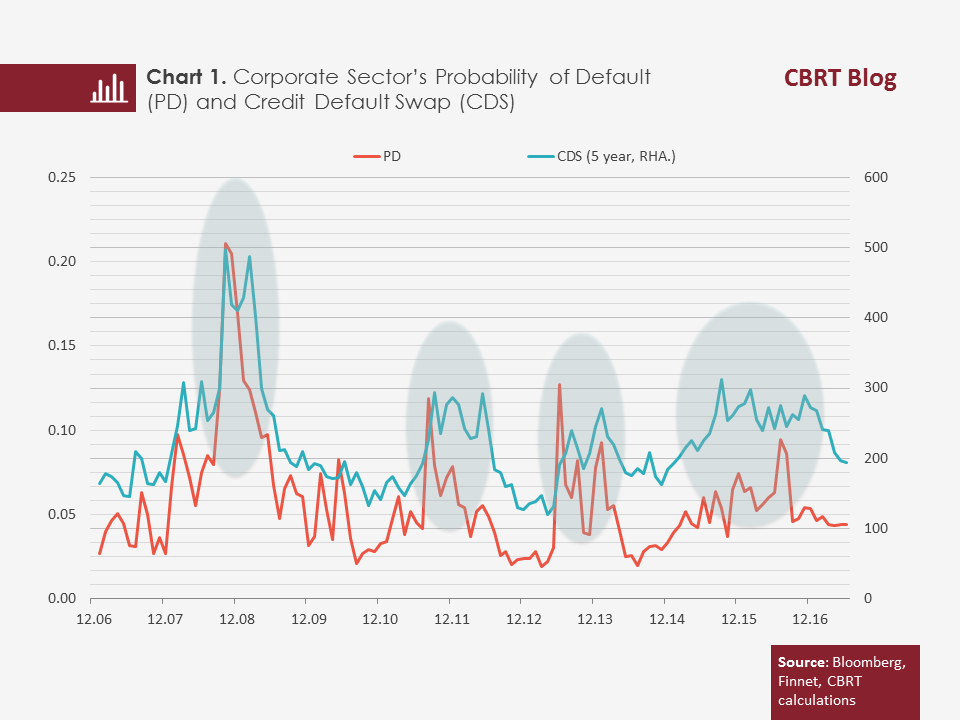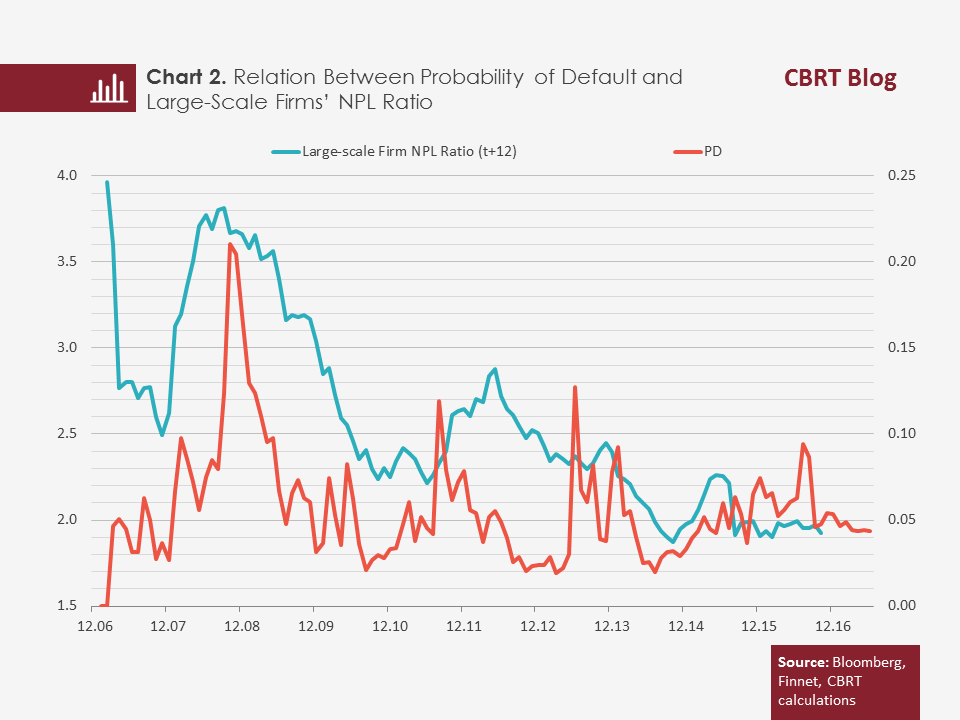The asset quality of the banking sector is determined by borrowers’ ability to repay their loans on time and properly as required. Since almost half of the banking sector’s assets are composed of corporate loans, analyses of banks’ asset quality should include an assessment of corporate sector financials. In fact, developments such as a deterioration in corporate sector’s financial indicators or an increase in bad checks and protested bills lead to a weakening in the asset quality of the banking sector and may be reflected in banks’ balance sheets as NPLs.
Analyses of corporate sector credit risk employ methods that focus on periodically published financial statement information (Altman z-score, etc.) as well as other methods such as the Merton option pricing method through which financial statement data and market data are interpreted together. In this study, firms’ market and balance sheet data are used together to estimate the default probabilities, and the capability of these estimations to increase the predictability of future changes in the banking sector’s asset quality is analyzed.
The asset size of corporate sector firms in Turkey is double the GDP, and almost half of it belongs to large-scale firms. Through the Entrepreneur Information System platform run by the Ministry of Science, Industry and Technology, these firms’ financial data are publicly disclosed on a yearly basis with a time lag. On the other hand, financial statement data of mainly large firms listed on the BIST can be accessed more frequently on a quarterly basis. For this reason, this study employs market data and balance sheet information of 278 corporate sector firms listed on the BIST[1]. The probability of default is estimated for these firms via the option pricing method (Merton model), and the relationship between the estimated probability of default and the asset quality of loans extended to large-scale firms by the banking sector is examined.
In Merton's option pricing method, there are two main assumptions. The first assumption is that the market price of a firm’s assets (AT) is the sum of the market value of equity and the firm’s liabilities which are considered as a zero-coupon bond with a face value of D at maturity T=t. The other assumption is that a firm's asset value behaves according to geometric Brownian movement. The amount that the lenders or shareholders will receive varies depending on the value of the firm’s assets. At maturity (t=T), if the firm’s asset value is greater than the value of the debt at maturity, then the lenders can receive the whole amount they lent while the potential gain by shareholders is limited to the remaining amount as lenders have precedence over shareholders. On the other hand, if the firm’s asset value is smaller than the value of the debt at maturity, the shareholders will not be able to receive anything while lenders will receive the total asset value.

Under these assumptions, the market value of the firm is priced primarily as a call option over the firm's assets. The strike price of this call option is the value of firm’s debt (D). In this context, the distance to default and the default probability of the firm are calculated by estimating the capacity of the market value of the firm’s assets to cover its debt.
In this study, first the volatility of return on equity is estimated by compiling share prices of BIST firms from stock market data. However, since data for market value of the firm’s assets (A) and its volatility cannot be observed in the market, they are estimated by solving non-linear equations using the firm’s total market value of equity, the volatility of return on equity, and debt data obtained from financial statements. It is assumed that the firm will default when the market value of the firm’s assets falls short of meeting the sum of short-term debt and half of long-term debt (default point). To calculate the probability of default that will cover all the firms in the study, the default probabilities calculated for every individual firm are weighted by the market value of these firms. The default probability may take a value between 0 and 1, where a value close to 1 implies an increased probability of default.
The weighted average default probabilities of the firms included in the sample are compared with the credit default swap (CDS) spreads of Turkey in Chart 1. The high correlation (80 percent) between the two data indicates that the calculated probability of default captures the movements in the risk premium. As a matter of fact, it can be seen that the default probabilities of the firms in this study increase, similar to the increase in credit default swap spreads due to the global crisis in 2008, the European debt crisis in 2011, the US tapering process in 2013, and the domestic and geopolitical developments in 2016.

This study also examines the relationship between the default probabilities of firms in the sample and the NPL indicators of banks. The NPL ratio of large-scale firms rather than SMEs is used since the firms listed on the BIST are relatively large-scale firms. The correlation between the weighted average default probability and the lagged value of large-scale firm NPL ratio has been examined with respect to different lag periods since the effect of an increase in the probability of default on NPL ratios of banks will appear with a lag due to legal regulations. Eventually, the highest value of correlation for these two series is recorded between the probability of default at period t and the NPL ratio at period t + 12 in the 2007-2016 period.[2]
Accordingly, the relationship between the corporate sector’s default probability at time t and the NPL ratio of large-scale firms at t+12 is examined. It can be said that the probability of firm default is successful in predicting the one-year-ahead increase in the NPL of large-scale firms, particularly for the global financial crisis period in 2008, the European debt crisis period in 2011 and the US tapering period in 2013 (Chart 2). The recent flat course in the probability of default may affect large-scale firms' NPL indicators positively in the upcoming period. On the other hand, it should be noted that we should leave a margin of safety in this inference because of the inclusion of the entire firm sample in the large-scale firm NPL ratio although the probability of default in the study is calculated for a limited number of firms.
To conclude, there appears to be a correlation between the developments in the firms’ default probabilities calculated by the option pricing model and the NPL ratios. Therefore, it is considered that it may be helpful to use the corporate sector default probabilities in credit risk analyses and in the studies to be carried out to monitor the asset quality of the banking sector.
[1] The ratio of asset size of these firms to GDP is around 19 percent.
[2] The increased correlation between the CDS and the probability of default in the 2007-2009 global crisis period significantly influences this result. The lag period, which gives the maximum correlation between these two variables, is approximately 3 months longer when the global financial crisis period is excluded.
Bibliography:
Blavy, R. and M. Souto, 2009, Estimating Default Frequencies and Macrofinancial Linkages in the Mexican Banking Sector, IMF Working Paper
Merton, Robert C., 1974, On the Pricing of Corporate Debt: The Risk Structure of Interest Rates, Journal of Finance 29, 449-470
Yıldırım Güngör, G., 2012, Bankaların Kurumsal Kredi Portföyü ve Kredi Riskinin Ölçümü (Banks’ Corporate Loan Portfolio and Credit Risk Measurement, in Turkish only)
